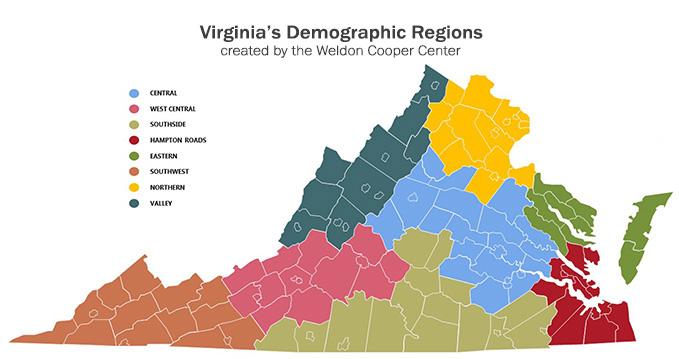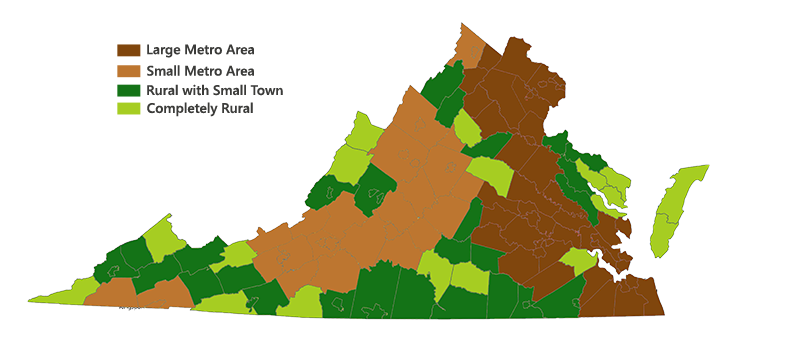Data Guide and Reference Maps
View all population dataGuide to Publicly Available Demographic Data
This data source guide is a reference tool describing data important to workforce professionals. We created the guide because multiple federal and state organizations provide data relevant to workforce professionals; and skillful data use requires understanding:
- the sources of data
- how often it is collected, for what years it is available, and a link to the data release dates
- the geographic level of analysis (state, county, etc.)
- the variables included in the data
- how to access and use the data
- Decennial Census
Source
U.S. Census Bureau, www.census.gov
Frequency of Data
- Collection: Every 10 years
- Release: Data Release Schedule for the 2020 Census
Geographic Levels
Nation, State, County, City, Census Tract and Census Block
Description
The U.S. Census counts every resident in the United States at 10 year intervals, as mandated by the Constitution. It provides a snapshot of each person living in the country on April 1 of the year in which the Census is conducted. The data collected by the decennial census affects the number of seats a state has in the U.S. House of Representatives and is used to distribute funding and allocate resources across localities and communities. The 2010 Census reported data on age and sex distributions, race, Hispanic or Latino origin, household relationship and type, the group quarters population, and housing occupancy and tenure (whether the housing occupant owns or rents).
Variables
2020 Census
- Household: Household Size, Tenure, by Type, and by individuals under 18 and by individuals 65+; Housing Occupancy, and Vacancy Rates.
- Demographic: Age, Sex (including sex by median age and by various age groups), Race, Hispanic or Latino Origin, Marital Status.
2000 and earlier
- Household: Household Size, Home Ownership, Mortgage Payment, Rent, Household Income, Government Subsidies, Number of Rooms and Bedrooms, Number of Mothers, Fathers, Couples, and Families.
- Demographic: Age, Race, Hispanic Origin, Gender, Marital Status, Birthplace, Ancestry, Citizenship Status, Language, English Pro?ciency.
- Education and Employment: School Attendance and Type, Grade Level, Educational Attainment, Employment Status, Labor Force Status, Occupation, Industry, Means of Transportation to Work, Carpooling, Travel Time to Work.
- Income: Personal Income, Wage/Salary Income, Social Security, Public Assistance, Poverty Status
- Migration: 5-Year Migration Status and Place of Residence, 5-Year Metropolitan Status.
- Disability and Veteran Status: Work Disability, Veteran Status, Service Period.
Access the Data
- 2020 Census Data | U.S. Census Bureau
- data.census.gov (formerly American Fact Finder) | U.S. Census Bureau
- Virginia-specific data
- Quick Facts Demographic Data | U.S. Census Bureau
- 2010 Virginia Demographic Profile | U.S. Census Bureau (pdf)
- National Historical Geographic Information System (NHGIS) | Minnesota Population Center
- Historical Census Data
- Data from previous censuses | U.S. Census Bureau
- Variety of historical census data and publications | The University of Michigan Library
- Census counts for Virginia localities, 1790-present | Weldon Cooper Center (excel spreadsheet)
Guides to Using the Data
- Online training courses | U.S. Census Bureau
- Census Primer | information from U.S. Census Bureau; compiled by Weldon Cooper Center
- American Community Survey
Source
U.S. Census Bureau, www.census.gov/programs-surveys/acs/
Frequency of Data
- Collection: ongoing
- Release: Data Release Schedule
Geographic Levels
Nation, State, County, City, Census Tract and Census Block Group
Description
The American Community Survey (ACS) is an ongoing survey that covers a sample of nearly 3.5 million addresses across the U.S. The data is released at 1- or 5- year intervals, with the discontinuation of the 3-year data product. The survey provides current data and allows a choice between single-year and multi-year estimates, depending on research needs with respect to currency, reliability and level of geography. The data helps local agencies and individuals – in both government, business, non-profits etc. – to better understand their communities and the workforce. The ACS provides information on a variety of subjects, including demographics, economics, housing and social situations.
Variables
- Demographic: Age and Sex, Group Quarters Population, Race, Hispanic or Latino Origin, Race, Relationship, Total Population.
- Economic: Class of Worker, Commuting to Work, Employment Status, SNAP, Health Insurance Coverage, Income and Earnings, Industry and Occupation, Poverty, Work Status
- Housing: Computer Ownership & Internet Access, House Heating Fuel, Occupancy/Vacancy Status, Occupants per Room, Owner Monthly Costs, Plumbing Facilities, Rent Statistics, Rooms, Bedrooms, Telephone Service Available, Tenure, Units in Structure, Value of Home, Vehicles Available, Year Householder Moved into Unit, Year Structure Built
- Social: Ancestry, Citizenship Status, Disability Status, Educational Attainment, Fertility, Field of Degree, Grandparents as Caregivers, Language, Marital History, Marital Status, Place of Birth, School Enrollment, Residence 1 Year Ago/Migration, Veterans, Year of Entry
Access the Data
- data.census.gov (formerly American Fact Finder)
- Integrated Public Use Microdata Series(IPUMS)-USA | Minnesota Population Center
Guides to Using the Data
- Current Population Survey (CPS)
CPS with the Annual Social and Economic (ASEC) Supplement
Source
U.S. Census Bureau and Bureau of Labor Statistics Partnership, www.census.gov/cps
Frequency of Data
- Collection: monthly (CPS)
- Release: Data Release Schedule
Geographic Levels
Nation, Region, State
Description
The Current Population Survey (CPS) is a monthly survey conducted on a sample of 60,000 occupied households; it provides information on labor force characteristics like issues related to employment and earnings, along with demographic data for the U.S. population. The March survey has a supplement (ASEC) that annually provides additional information on income, health insurance, school enrollment, etc. The survey excludes institutional group quarters and military who reside in military barracks. The lowest level of geography at which the CPS is available is the state and the twelve largest metropolitan statistical areas.
Variables
- Household: Household Income, Government Subsidies, Number of Fathers, Mothers, Families, and Couples.
- Demographic: Age, Race, Hispanic Origin, Gender, Marital Status, Birthplace, Mother’s Birthplace, Father’s Birthplace, Ancestry, Citizenship Status.
- Education and Employment: School Attendance, Educational Attainment, Employment Status, Labor Force Status, Occupation, Industry, Class of Worker, Full/Part-Time, Pension at Work, Union Membership, Reason for Unemployment, Firm Size.
- Income: Personal Income, Wage/Salary Income, Social Security, Public Assistance, Poverty Status, Retirement Income, SSI Income, Income from Interest, Unemployment Bene?ts, Worker’s Compensation, Veterans Bene?ts, Survivor Bene?ts, Disability Bene?ts, etc .
- Migration: 1-Year Migration Status and Place of Residence, Reason for Moving.
- Disability and Veteran Status: Work Disability, Health Status, Quit Job for Health Reasons, Veteran Status, Service Period.
- Health Insurance: Coverage Status, Insurance Type (Employer, Private, etc.), Medicaid, Medicare, VA/Military Health Insurance, State Children’s Health Insurance.
- Welfare: GED Classes, WIC, Job Search Program, Job Readiness Training, Job Training, Child Care Assistance, Transportation Assistance, Work Program for Cash Assistance.
Access the Data
- CPS Data | U.S. Census Bureau
- Integrated Public Use Microdata Series (iPUMS)-CPS | Minnesota Population Center
Guides to Using the Data
- Why and when the CPS was established
- CPS Supplemental Surveys | Comprehensive list with dates and purpose
- CPS Definitions
- Longitudinal Employment-Household Dynamics (LEHD)
Source
U.S. Census Bureau and Virginia Employment Commission, https://lehd.ces.census.gov/
Frequency of Data
Collection: quarterly (CPS)
Geographic Levels
Nation, State, County, Metropolitan/Micropolitan Area, County, Workforce Investment Area.
Description
The Longitudinal Employer-Household Dynamics (LEHD) program is a combination of administrative records along with censuses and surveys; this compiled data provides statistics on employment, earnings, and job flows at detailed levels of geography and industry and for different demographic groups. In addition, the LEHD program uses its data to create partially synthetic data on workers’ residential patterns. The Local Employment Dynamics (LED) refers to the partnership between the Census and other state/federal agencies to cooperate and collaborate, under which states agree to share Unemployment Insurance earnings data and the Quarterly Census of Employment and Wages (QCEW) data with the Census Bureau. The Quarterly Workforce Indicators (QWI) and LEHD Origin-Destination Employment Statistics (LODES) are data products/tools developed and released under the LED.
Variables
- Demographic: Age Group, Gender, Education, Race, Ethnicity.
- Industry: 3-digit NAICS code, 4-digit NAICS code.
- Workforce Indicators: Employment, Hires, New Hires, Separations, Turnover, Average Monthly Earnings for All Employees, All Hires, and New Hires, Total Payroll, Firm Job Gains, Firm Job Losses.
Access the Data
- LEHD Data | U.S. Census Bureau
- QWI Explorer | U.S. Census Bureau
interactive access to Quarterly Workforce Indicators dataset, including charts, maps and tables. - OnTheMap | U.S. Census Bureau
maps where workers are employed and where they live with reports on worker characteristics - LED Extraction Tool | U.S. Census Bureau & LED Partnership
access to raw data
Guides to Using the Data
- LEHD Data Guides, Documentation and Help Sheets, including…
- LED Help Sheet (pdf)
- QWI Help Sheet (pdf)
- OnTheMap Help Sheet (pdf)
- U.S. Population Migration Data
Source
Internal Revenue Service, www.irs.gov/uac/Tax-Stats-2
Frequency of Data
Collection: annually
Geographic Levels
State, County
Description
U.S. Migration data is based on year-to-year address changes reported on individual income tax returns filed with the IRS. They present migration patterns by State or by county for the entire U.S. and are available for inflows—the number of new residents who moved to a State or county and where they migrated from, and outflows—the number of residents leaving a State or county and where they went.
Variables
- Number of returns filed, which approximates the number of households that migrated
- Number of personal exemptions claimed, which approximates the number of individuals
- Total adjusted gross income, starting with Filing Year 1995
- Aggregate migration flows at the state level, by the side of adjusted gross income (AGI) and age of the primary taxpayer, starting with Filing Year 2011.
Access the Data
- Migration Data | Internal Revenue Service (IRS)
- 2019-2020 Migration Data | Internal Revenue Service (IRS)
Guides to Using the Data
- Virginia Employment Commission (VEC) Data
Source
Virginia Employment Commission (labor market information), https://virginiaworks.com/
Data Available
- Employment Data
- Industry Data
- Quarterly Census of Employment and Wages | industrial data such as number of establishments within an industry sector.
- Current Employment Statistics | data on current employment, previous year’s employment, etc.
- Industry Projections | projected employment information by industry
- Occupation Data
- Occupational Employment Statistics | employment and wage rates for selected occupations.
- Occupational Projections | long and short-term by occupation
- Other Resources
- Business Employment Dynamics (BED) Data for Virginia
- Community Profiles
- U.S. Bureau of Labor Statistics (BLS) Data
Source
Bureau of Labor Statistics, https://www.bls.gov/data/
Data Available
Access all BLS data on the SUBJECTS AREA page of their website.
Below is a sampling of the type of data available.- Inflation & Prices | consumer, producer and import/export price indexes, consumer expenditure survey (buying habits of American consumers)
- Employment | labor force statistics (national employment/unemployment data), job openings and labor turnover survey, employment and wage data by industry and geographic area (QCEW), occupational employment statistics (OES), employment projections …
- Unemployment | national, state and local unemployment rates, mass layoff statistics
- Pay & Benefits | National Compensation Survey, benefits, local industry wages, earnings statistics from the CPS …
- Spending & Time Use | Consumer Expenditure Survey, American Time Use Survey
- Productivity | quarterly labor productivity, annual indexes for industry productivity …
- Workplace Injuries
- International | comparative productivity and labor costs by country …
- Regional Resources | regional offices, including Mid-Atlantic and Southeast …






